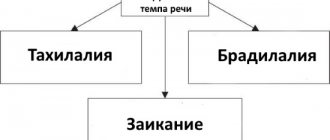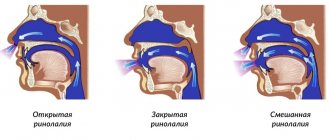Rate of speech is a sign of speech function, which facilitates the perception of heard information by others. Changes in speech rate include slowing down, speeding up, and stuttering. An incorrect speech rate can impede the development and learning of children, reduce the quality of life, and worsen a person’s social adaptation. Patients with accelerated, slow speech or stuttering require mandatory correction of speech defects. For children, therapy is prescribed as early as possible to prevent developmental delays.
Types of speech rhythm and tempo disorders
Not only a speech therapist, but also parents and teachers can hear that a child’s speech deviates from the normal pace and the rhythm is disturbed, but only a specialist can determine the structure and cause of the defect.
Violations of the tempo and rhythm of speech include:
- Tahilalia is the accelerated pronunciation of words, sounds, syllables at a speed of 20-30 sounds per second (instead of 9-14 normally). The rapidity of speech negatively affects the articulation of sounds. Pathology occurs in childhood, becomes established during adolescence, and can remain with a person for life.
- Bradylalia is a pathologically slow speech, most often found in children with mental retardation or mental retardation, since violations of basic mental processes (memory, attention, thinking) and fine motor skills are often observed in parallel with bradylalia.
- Stumbling - against the background of accelerated speech, repetition of words, syllables and sounds occurs. It must be distinguished from stuttering, since stumbling does not have convulsions of the speech apparatus in its etiology; a child or adult with stumbling does not experience fear of speaking.
- Stuttering - during a statement, involuntary stops occur that are beyond the control of the stutterer. They are accompanied by convulsions of all parts of the speech apparatus.
Symptoms of speech tempo and rhythm disorders
With tachylalia (accelerated speech rate), the rapid flow of utterance stuns the interlocutor, whom the speaker practically does not listen to the end of, and often interrupts. The articulatory apparatus does not have time to clearly pronounce sounds, syllables and words; the entire utterance is pronounced in one exhalation, without respite. Tachylalia may be accompanied by twitching of the body or separately of the arms and legs, and grimacing.
Stumbling is distinguished, in addition to the frequent repetition of speech units, by unjustified pauses in speech, stops in the middle of a speech utterance. Unlike stuttering when stumbling, a child’s speech does not deteriorate in front of an unfamiliar audience and does not have periodicity.
With bradylalia , the articulation of sounds is sluggish and unclear, vowel sounds are pronounced stretched out. The voice is monotonous, the statements are not emotionally colored, they lack characteristic modulations. Speech is so slow that it causes impatience and irritation among others.
Children, seeing such an attitude, try to remain silent more often than to speak. This position further retards their mental development. According to scientific research, with bradylalia, not only external, but also internal speech has a slow pace.
Stuttering has a wide clinical picture. It is characterized by the following symptoms:
- Convulsions of all parts of the articulatory apparatus.
- Accompanying movements of the muscles of the face, neck, arms and legs - squinting, stomping, clenching fists, frequent blinking.
- Speech tricks - all kinds of “uh”, “well”. “so”, “here”, etc.
- Fear of speech, fear of pronouncing individual sounds and words.
- Increased stuttering when communicating with unfamiliar people.
Behavioral techniques
Below are basic guidelines for speaker behavior in front of an audience. All these recommendations are divided into 3 groups: postures, gestures, facial expressions. To some experts, these features of the speaker’s behavior seem not very significant and exclusively subjective, while others, on the contrary, believe that almost the most important role should be given to this.
In this section we largely adhere to the first point of view. The authors believe that the main principle of behavior on stage is socially acceptable behavior in which the speaker feels free, natural and confident. If you try to consciously control your posture, gestures and facial expressions during the speech, you risk looking awkward, too tense and missing out on other more important details of the speech regarding its content.
1
Pose
The speaker's posture directly depends on the personal qualities of the speaker and the circumstances of the speech. If you try to find the most general recommendations regarding posture, you can quote the words of Heinz Lemmermann that a good speaker is neither a fidget nor a pillar. It is best when the speaker's posture expresses calm and confidence, and his gestures are free and well-coordinated, rather than careless and provocatively chaotic.
So, general recommendations for behavior during a speech: be natural and behave appropriately to the situation. For example, a hand in your pocket will not be a strong obstacle during a business conversation within a team, but at a product presentation for investors it may look a little vulgar. Try to intuitively imagine the posture of a person whose performance you yourself would like to watch and listen to; your internal guidelines will certainly help you choose an appropriate model of behavior in public.
In the specialized literature on oratory, you can find the following recommendations regarding the speaker’s posture while delivering a speech:
- do not keep your hands in your pockets (most speakers successfully break this rule);
- do not cross your arms over your sternum;
- do not keep your hands behind your back;
- do not slouch, and vice versa, do not stick out too much.
It's also best to try to get rid of some bad habits if they stand out in your performance. Some people often shrug their shoulders, shake their legs, nod their heads, take off and put on their glasses, stroke an imaginary beard, tug at their ears or twirl various objects in their hands, etc. This is not as much of an obstacle as it might seem at first glance, but if you feel that it is interfering with your performance and distracting you and the audience from the content of your speech, try to avoid these obsessive actions or switch to other gestures.
2
Gesticulation
Lively gestures help us express our thoughts more clearly, emphasize important points, and support an emotional impulse. Some gestures can also be used for visualization: showing a number on your fingers, demonstrating the approximate size of an object, pointing to a board or illustration. Many of you can easily express invitation, refusal, encouragement, question, doubt and other communicative intentions using gestures.
However, at the same time, we are unlikely to see the same gestures performed by different people, since gesturing systems are diverse not only in different countries, but also among representatives of the same nation. There are no standard gestural figures, but body language always accompanies our thought process.
One scientist, Albert Meyerabian, found that information transmission occurs only 7% through verbal means, 38% through auditory means, and 55% through the remaining non-verbal means. This is not difficult to believe, remembering, for example, silent films and films with Charlie Chaplin.
This great actor (who, by the way, is also considered a great orator), without uttering a single word in his films, was able to convey to the audience an incredible number of shades of meaning, emotions and very clearly talk about any situation just using gestures, facial expressions, language bodies.
3
Facial expressions
The speaker's facial expressions also convey some information to the audience. It is important that your facial expressions are natural and appropriate to the situation, then they will work to your advantage. Otherwise, it is better not to try to deliberately portray a facial gesture, and get carried away with improvisation if you do not have professional acting skills.
It's rare to find people who lack facial expressions, so you most likely already use them in your speeches. For example, if you speak with sarcasm, then you probably squint your eyes a little and make a barely noticeable grin, and when you tell some non-obvious fact, you open your eyes a little wider.
To visualize what your audience will see during your speech, go to the mirror and try to use facial expressions to depict emotions corresponding to the following situations:
| 1 | You are talking about a serious issue that concerns you and your audience. |
| 2 | You offer a quick and effective solution to this problem. |
| 3 | You are commenting on your opponent's erroneous point of view. |
| 4 | You are being ironic about a situation. |
| 5 | You are communicating something unexpected. |
| 6 | You say the most important points of your speech. |
Among other things, pay attention to your eyes. The look shows your interest in communicating with the people who came to the performance. If you look over the heads of your listeners or, conversely, at the floor, then it is not difficult to conclude that you are interested not so much in conveying information to people as in simply delivering your prepared speech correctly.
It is important to try to establish visual contact with the people in the room, periodically looking from one person to another. Most likely, you will find those who agree with you, watching you supportively or nodding. If, out of excitement, you begin to move your gaze too quickly and often, such behavior may reveal your worries and insecurities.
During a speech, it is very important to take into account not only the content of the speech, but also the behavior of the speaker in the process of delivering it, since it is behavior that allows you to establish contact with the audience and correctly present the prepared material to them.
For listeners and viewers, it is not only the information that they receive that is important, but also a living person, a speaker who, unlike the author of the book, offers the audience live communication and allows them to introduce some interactivity into the ongoing process.
The initiators of this process are skillful speakers, thanks to their correct behavior, expressive gestures and facial expressions, we listen to their speeches with great enthusiasm. We encourage you to experience the performances of experienced, renowned speakers who have all the necessary qualities to gain the attention and respect of an audience. These qualities are naturally combined in their behavior in front of the public.
If you feel that your public speaking lacks behavioral factors, correct posture, bright gestures and expressive facial expressions, you will certainly need acting skills, which you can read about in the acting training that is being developed.
Examination of children with violations of the tempo and rhythm of speech
If parents suspect that their child has disturbances in the tempo and rhythm of speech, they should consult with a speech therapist at a children's clinic, speech center, school or kindergarten. Sometimes you can hear the erroneous opinion that you should not start correcting speech deficiencies until the child is 5 years old.
This is partly true for uncomplicated cases of sound pronunciation formation, since the speech apparatus has not yet been formed, and sounds can appear on their own. In all other cases, the sooner correction work begins, the more successful it will be.
At the initial visit, the specialist is required to conduct a speech therapy examination. The main directions of this survey:
- Establishing the cause and nature of speech impairment.
- Determining the rate of speech of the child and his parents.
- Diagnosis of basic mental processes (memory, attention, thinking).
- Studying the history of speech development - the appearance of the first words, phrases, the likelihood of parents forcing the child’s speech. Bilingualism in the family.
- Determining the style of family education, attitude towards the child, the presence of conflicts, difficult life situations.
- Collecting anamnesis of the disorder and concomitant pathologies.
- Determination of existing articulation deficiencies.
- Correspondence of the level of speech development of the child to the age norm.
Perhaps some questions may seem unnecessary to parents, but the speech therapist does not ask them out of idle curiosity - there are no trifles in the development and correction of speech disorders, the situation in the family and the presence of psychological problems are very important.
Therapeutic measures
Treatment measures include eliminating the causes of speech dysfunction, as well as corrective work. If a child has a pathology that has caused a change in speech, he is first prescribed a course of treatment. Upon completion of therapy for the underlying disease, the patient is referred to a speech therapist. The speech therapist draws up a plan for speech therapy sessions. Correction is carried out both at home and in educational institutions. The number of classes is determined by the severity of speech disorders.
For bradyllalia, speech therapy classes are aimed at developing a faster pace of conversation and training the articulatory and motor apparatus. The speech therapist teaches the child to write, read, and clearly pronounce phrases and sentences faster. The classes train memory and attention. Outdoor games, skits, and dialogues are actively used, which help accelerate the pace of speech function. A good effect from the correction can be expected after 4 weeks. During a monthly course of therapy, speech speed becomes faster and pronunciation becomes clearer.
Children with slow speech need to conduct independent studies at home and control their conversation.
When treating tachylalia, a speech therapist conducts classes that include breathing training (slow, even), reading, and orderly, calm speech. The specialist teaches the child to work with a team, organizing performances in front of a group of people or children. During classes, they must develop general, auditory attention and train diction. The course of treatment for preschoolers and primary school students is 6-12 months.
It is better to correct tachylalia as early as possible (before 5 years of age), since therapy is less effective during puberty.
Stuttering correction is carried out at home and in the speech therapist's office. Family members need to avoid conflict and speak slowly and clearly. During treatment, it is better to refrain from visiting kindergarten for 2 months, events, and holidays, so as not to excite the patient. The correction course includes physical activity (running, swimming, cycling). During classes, you need to practice counting (count clothespins by attaching them to paper cut out in the shape of a circle), and use silent games. For correction, tongue twisters, gymnastics for the articulation apparatus, and breathing exercises are used.
Causes of speech pathologies
The basis for disturbances in the tempo and rhythm of speech is an incorrect relationship between the processes of excitation and inhibition in the cerebral cortex.
The causes of tachylalia (accelerated speech rate) are:
- The predominance of excitation processes in the cerebral cortex, responsible for the formation of speech.
- Heredity, congenital characteristics of temperament.
- Imitating the fast-talking of others, mistakes in education - such speech is most often found in unbalanced and excitable children.
The causes of bradyllalia (slow speech) can be:
- Dominance of inhibition over excitation in the speech areas of the cerebral cortex.
- This feature of external and internal speech can be inherited.
- Pathology appears as a result of a child’s imitation of incorrect speech patterns from others.
Causes of stuttering can be:
- Unbearable speech load (learning large poems, memorizing texts that are not age appropriate, memorizing difficult and obscure words).
- Frequent punishment of children, sudden and severe fear, mental trauma due to improper upbringing.
- Excessively accelerated speech due to imitation of family members, getting stuck on individual sounds during speech;
- Traumatic brain injuries, neuroinfections.
The main factors provoking pathology of speech development are congenital or acquired weakness of the nervous system and a decrease in its stability.
Diagnostic measures
Diagnosis of speech dysfunction (tachylalia, bradylalia, stuttering) includes identifying the cause of the disease. The child is referred to a neurologist. The neurologist conducts an examination, collects anamnestic data (speech function of relatives, pathologies of pregnancy and childbirth), prescribes an examination (electroencephalogram, magnetic resonance imaging, ultrasound examination of blood vessels and other techniques). If there are mental traumas that contribute to the occurrence of stuttering, the patient is referred to a psychologist. After the examination is completed, a speech therapist works with the child by specialized specialists.
The speech therapist also collects anamnestic data on the speech characteristics of relatives, looks at the examination results, and conducts a speech therapy study. The specialist determines the state of the child’s motor activity (general, speech), evaluates speech function (quality of pronunciation of sounds), rate of speech: fast, slow, stuttering. It is also important for a speech therapist to know the state of the articulatory apparatus and facial muscles. If the child can write and read, the specialist assesses the state of writing and reading (speed, correctness of words, presence of pauses in sentences, presence of stuttering, hesitation during reading, speed and correctness of writing words and sentences). At the end of the examination, the speech therapist draws up a speech therapy report.
What should parents do if their child has a speech disorder?
You should not try to correct this pathology through prohibitions and shouts like “Come on, stop making faces, speak correctly now.” Since these disorders are closely related to the state of the nervous system, you should try to create a calm atmosphere in the family, try to adjust communication with the child, and establish a trusting relationship.
Correction of speech disorders should be carried out by a qualified speech therapist. It is advisable to consult with a neurologist, psychotherapist, or psychologist who works with children with developmental disabilities before starting classes. You will have to be prepared for the fact that the cycle of correctional classes will be long - several months, perhaps several years.
If there are people in the family with speech impairments, you need to work on correcting it. It is advisable for the child to hear calm, quiet speech around him at a leisurely pace for imitation. It is necessary to celebrate any, even the smallest, successes of the child, convince him that the defect can be overcome, and encourage him.
To strengthen the child’s nervous system, it is advisable to carry out general strengthening measures:
- Hardening.
- Doing feasible sports.
- Taking vitamin complexes, a large amount of fresh vegetables and fruits in the diet.
- Maintaining a daily routine.
- Optimization of teaching load.
- As recommended by your doctor, take antipsychotics.
Compliance with such recommendations will lead to the correction of speech disorders.









